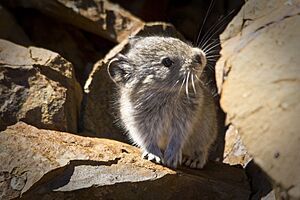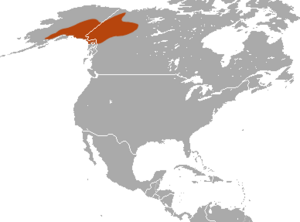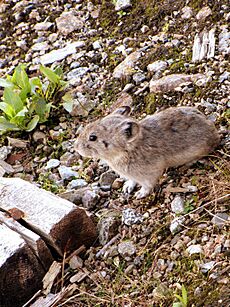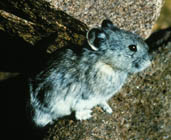Collared pika facts for kids
Quick facts for kids Collared pika |
|
|---|---|
 |
|
| Collared pika at Denali National Park | |
| Conservation status | |
| Scientific classification | |
| Genus: |
Ochotona
|
| Species: |
collaris
|
 |
|
| Collared pika range | |
The collared pika (Ochotona collaris) is a small mammal that looks a bit like a rabbit. It belongs to the pika family. Pikas are part of a group called Lagomorpha, which also includes rabbits and hares.
This little animal weighs about 160 grams (5.6 ounces). It lives in rocky areas in the mountains of central and southern Alaska in the United States. You can also find it in parts of Canada, like northern British Columbia, Yukon, and the western Northwest Territories.
The collared pika is very similar to the American pika. Its name comes from the gray fur patches on its neck and shoulders, which look like a "collar." Collared pikas prefer to live alone. They do not hibernate during winter. Instead, they spend much of the summer gathering plants. They store these plants under rocks in "haypiles" to eat when winter comes. Some pikas have even been seen eating dead birds for extra fat and protein. They make thousands of trips in July and August to collect enough food for the cold months.
Contents
What Does a Collared Pika Look Like?
Appearance and Size
Collared pikas look a lot like other pikas. Their fur is dull grayish on their backs. They have gray patches on their shoulders and neck, forming a soft "collar." Their bellies are white. In winter, their fur is thicker. In other seasons, it is a darker gray and not as thick. They only shed their fur once a year.
Young pikas look fully gray in the summer. Adult pikas have a brownish tint around their heads and necks. You can tell a collared pika from an American pika by the creamy fur near its face. The American pika has brown fur there. Collared pikas also have slightly wider skulls. They have a shorter nose area and different teeth.
These pikas are small, weighing between 130 and 200 grams (4.6 to 7 ounces). They are about 18 to 20 centimeters (7 to 7.8 inches) long. Their back legs are a bit longer than their front legs. They have five toes on each front foot and four on each back foot. Their feet are covered with long fur, but their toe pads are still visible. They have curved claws.
Where Do Collared Pikas Live?
Geographic Distribution
Collared pikas live across a large area. This includes western Northwest Territories, most of the Yukon Territory, northern British Columbia, and central and southern Alaska. About 60% of collared pikas live in Canada, mostly in Yukon.
In Alaska, they are often found in the Yukon-Tanana uplands and Chigmit Mountains. In Canada, they live from the Richardson Mountains south into northwestern British Columbia. They are also found near the Mackenzie River in the Northwest Territories.
Only two pika species live in North America: the collared pika and the American pika. The collared pika lives much farther north than the American pika. There is a gap of about 800 kilometers (500 miles) between their living areas in British Columbia and Alberta, Canada.
Ancient Pikas
Scientists found preserved collared pika fossils in central Alaska in 1973. They also found some ancient pika droppings. Early fossils were also found in the Yukon territory. Studies of these fossils show that ancient pikas could change their body shape. This helped them adapt to changing environments long ago. The collared pika may have become its own species during a time of ice ages, separating from the American pika.
Habitat and Environment
Collared pika groups mainly live in mountain regions. They usually make their homes in rock slides near areas with lots of plants and meadows. For example, some collared pikas have been found living in rock piles in Denali National Park. Because they live in these scattered rock areas, their population is broken into many smaller groups.
Their home areas are about 30 meters (98 feet) wide. Their food storage spots and dens are usually 30 to 70 meters (98 to 230 feet) apart. Collared pikas, like most pikas, live around rock slides. They use the rocks to protect themselves from high temperatures during the day. They are known as "cold-adapted" animals.
How Do Collared Pikas Behave?
Collared pikas are active during the day. They are herbivores, meaning they eat plants. They spend their summers looking for plants to add to their food piles, a process called "haying." This is what they do for most of the day. They do not dig burrows. Instead, they use the cracks and spaces in the rock slides for shelter. They are most active in the morning and late afternoon.
Each collared pika protects its own territory and its own food pile. They defend it strongly. This means collared pikas prefer to be alone and are not very social.
During the cold winters, collared pikas do not hibernate. They stay active, relying on their stored food for energy. They use the snow as a blanket to keep warm. The distance a pika travels to find food depends on how much danger there is from predators. Pikas rarely go more than 10 meters (33 feet) away from their rock home when gathering food.
They start gathering food around late June or early July. They collect more and more as summer goes on. Collared pikas often have several small food piles in their home area. They usually put these piles in the same spot each year. They focus on one main pile, while the others are smaller. They will use whatever is near the rock slides, like leaves, flowers, or berries. Sometimes, even animal droppings have been found in their food piles! The size of their food pile depends on the size of their shelter.
Collared pikas sometimes steal food from other pikas. When they rest, they often sit on rocks and enjoy the sunlight.
How Do Collared Pikas Reproduce?
Collared pikas usually mate with their closest neighbors. They are thought to be mostly monogamous, meaning they have one partner. However, males sometimes visit several females' territories in spring before mating. The main mating season is in May and early June.
Both male and female collared pikas can have babies when they are one year old. The female gives birth to two or three young each year in her nest within the rocks. She usually has one litter per year. Sometimes, she might have two litters if the first one doesn't survive well.
The female pika does most of the work raising the young. She uses a lot of energy during pregnancy and when feeding the babies. It's hard to tell how much the male helps because males and females look very similar.
A female's pregnancy lasts about 30 days. She gives birth to blind and almost hairless babies. The young stay in the nest for about 30 days. After that, they are ready to leave the nest and find their own territories. Young pikas reach adult size in about 40 to 50 days.
For animals living in northern mountains, the timing of giving birth is very important. This is because the snow-free time is short, and food can be scarce. Most collared pikas give birth around the same time. However, some studies show that the timing of the first litter can depend on when the snow melts. This varied breeding might help ensure some babies survive, especially when snowmelt is unpredictable.
How Do Collared Pikas Communicate?
Collared pikas are quite vocal. We don't know everything about their calls, but studies on American pikas suggest calls are used for defense and to warn about predators. When a collared pika is about to call, it sits with a hunched back and points its nose up.
Collared pika calls sound like a repeated, sharp single note. Each series of calls can vary in loudness. It is similar to the American pika's short call. When pikas interact in their territory, they use a softer call. Both males and females can make calls from a fixed spot in their home area, especially when gathering food. This territorial call tells neighboring pikas that a food pile belongs to them. During mating season, adult males have a special call that sounds like strong "kie" calls and clicking sounds.
Population and Conservation
About 6 to 7 collared pikas can live in one hectare (2.5 acres). In some parts of the Yukon, it's about 1 to 4 pikas per hectare. Both collared pikas and American pikas tend to stay close to where they were born. Young collared pikas rarely move more than 300 meters (980 feet) from their original den. Adults hardly ever leave their established territory.
We don't know the exact population trend for collared pikas. However, their numbers have been going down in the Yukon since 1995. There's a chance they could disappear from that area in 10 to 15 years. Collared pikas are adapted to cold weather. This means they are not very good at handling climate change. So, populations living at lower altitudes and latitudes are at high risk of disappearing. Because of this, collared pikas are seen as an "indicator species." This means they show how climate change is affecting mountain environments.
Lifespan and Dangers
Collared pikas can live up to 7 years in the wild. Many pikas die during winter. Their population has been shrinking over time. Surviving winters is hard. Fast climate changes affect their growing season and how much food is available. For example, if there isn't enough snow, they lose their insulation. Their food and shelters are also less hidden from predators.
Predators
Collared pikas cannot defend themselves well against predators. They can only hide in cracks or crevices in the rocky mountains where they live. The rocks are their only shelter. One of their main predators in south-central Alaska is the stoat. Other predators include martens, weasels, foxes, eagles, coyotes, and various birds. Collared pikas can also get parasites like fleas and worms.
Conservation Status
The IUCN Red List of Threatened Species says the collared pika is of "least concern" for conservation. This means it's not currently considered endangered. However, the Committee on the Status of Endangered Wildlife in Canada thinks they are of "special concern." This is because collared pikas live in areas with fast climate changes and are sensitive to these changes.
Currently, no specific actions are being taken to protect this species. No major threats have been officially recognized. Still, collared pikas might be harmed by climate change. Also, new hunting rules in Alaska allow year-round hunting of collared pikas. This should be watched carefully to see if it has a negative effect.
Images for kids









